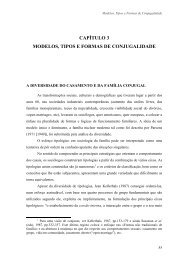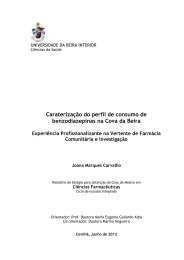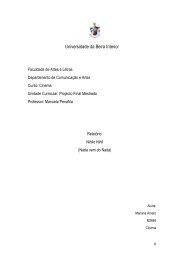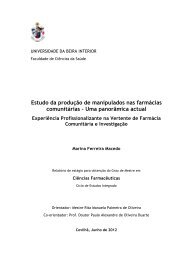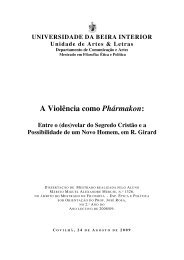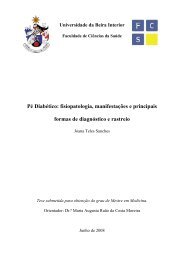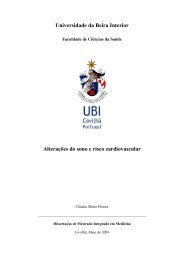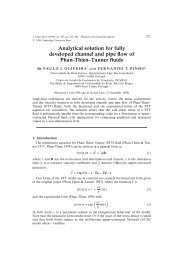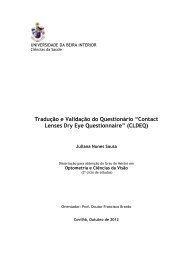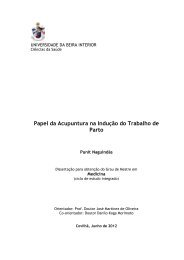Tese_Tânia Vieira.pdf - Ubi Thesis
Tese_Tânia Vieira.pdf - Ubi Thesis
Tese_Tânia Vieira.pdf - Ubi Thesis
You also want an ePaper? Increase the reach of your titles
YUMPU automatically turns print PDFs into web optimized ePapers that Google loves.
Chapter I - Introduction<br />
released by AgNPs in aqueous solution (Martinez-Castanon et al. 2008; Vertelov et al. 2008; Juan<br />
et al. 2010) that enhance their bactericidal activity (Rai et al. 2009; Juan et al. 2010; Kurek et<br />
al. 2011), have been explored extensively (Nagy et al. 2011). Several mechanisms of how AgNPs<br />
act against bacteria and allow their destruction have been proposed (Ruparelia et al. 2008).<br />
Among the hypotheses that have been proposed to explain the mechanism of antimicrobial<br />
activity of AgNPs, it is believed that Ag + interact with the bacterial cell wall peptidoglycans<br />
(sulfate, oxygen and nitrogen), promoting bacterial lysis through the potassium release from<br />
bacteria (Rai et al. 2009). AgNPs can be incorporated through the cell membrane by the same<br />
mechanism of Ag + (Lu et al. 2008; Maneerung et al. 2008; Ruparelia et al. 2008; Rai et al. 2009).<br />
Nanoparticles may attach on the surface of the cell membrane and disturbs its power function,<br />
such as electron transport chain and permeability (Martinez-Castanon et al. 2008; Raffi et al.<br />
2008; Gurunathan et al. 2009; Li et al. 2010; Fuertes et al. 2011). A damage in the membrane<br />
permeability affects the transport through the plasma membrane, like the efflux of reducing<br />
sugars and proteins as well as the depletion of the levels of intracellular adenosine triphosphate<br />
(ATP) (Raffi et al. 2008; Xu et al. 2011). This makes the bacterial cells incapable of properly<br />
regulate the transport through its membrane, resulting in cell dead (Ruparelia et al. 2008). In<br />
Gram-negative species, like E. coli, AgNPs are responsible for the formation of irregular shaped<br />
“pits” in the outer membrane of the bacteria. Such “pits” are accountable for the increase of<br />
the cell wall permeability by progressive release of lipopolysaccharides (LPS) molecules and<br />
membrane proteins (Raffi et al. 2008; Mirzajani et al. 2011) resulting in the collapse of the cell<br />
membrane potential (Xu et al. 2011). In addition, it is believed that silver binds to functional<br />
groups of proteins, resulting in protein desnaturation (Raffi et al. 2008).<br />
In addition, cell membrane disruption also allows the passage of AgNPs into cytoplasm<br />
(Ruparelia et al. 2008; Li et al. 2010; Kurek et al. 2011; Potara et al. 2011). Subsequently, AgNPs<br />
interact with phosphates of DNA (Thomas et al. 2007) and it loses its replication ability<br />
(Martinez-Castanon et al. 2008; Raffi et al. 2008; Vertelov et al. 2008). In a study performed by<br />
Raffi and colleagues, they reported that DNA may have lost its replication ability and cellular<br />
proteins became inactive, after cells being treated with AgNPs (Raffi et al. 2008). The entrance<br />
of such nanoparticles inactivate their enzymes, generate hydrogen peroxide and cause bacterial<br />
cell death (Raffi et al. 2008).<br />
Other important factor that is involved on antimicrobial mechanism of AgNPs is the<br />
formation of reactive oxygen species (ROS) (Lu et al. 2008; Kurek et al. 2011; Potara et al.<br />
2011). The formation of ROS is one of the primary mechanisms of nanoparticle toxicity, and<br />
these are thought to result in damage of proteins and DNA, as well as perturb cell membrane<br />
integrity (Kurek et al. 2011; Nagy et al. 2011). Furthermore, the ROS facilitate the interactions<br />
of AgNPs with the bacteria through the membrane lipid peroxidation (Kurek et al. 2011).<br />
A short summary of AgNPs mechanisms of action against bacteria are presented in figure 2.<br />
12




